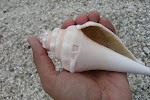I wanted to talk stories about my latest find. Usually, I get too
excited and pick up what I find right away without recording the object
in its natural state. In science it is important to note and record how an object is situated in the original, natural or its existing place or position (in Latin it is in situ). Many times I would often say to myself, "Man, I should have taken a picture of that before I picked it up". This is probably why we are not in the books yet for the Mary's Bean that I found that I know broke the drift record.
On a nature walk, I was just commenting to my BFF that we should be finding something on this road, when lo and behold - could it be? Is it really? Wait! I better get a picture before I dig it out!

Yes it is - a sling stone! The Chamorro name for sling stone is acho' atupat (or atupak)
and produced them as early as the Latte Period/Phase (1000-250 BP). History
books describe them as egg or acorn-shaped stones fashioned with
“jasper-like” stone, or with sun or fire-hardened clay. People now use
the words biconical or football-shaped to describe them. The ancient
people wielded them with deadly accuracy.
Here's beautiful Laurina modeling the acho' atupat for me. Most of the sling stones I've found are from the beach but this one was more inland. It is the most polished one I've found so far with only a minor scratch from where a car or cars probably ran over it. "Jasper-like" indeed!I'll have to compare this one to the others that I have found in another post so you can see the different variations in shape and materials. We are really blessed to find this special specimen from Laurina's ancestral past.
The craftsman really put a lot of time and effort in making this artifact. Here it is after washing and brushing off the dirt. So beautiful!
Let's talk stories some more. Till nest time, friends.
Ti napu,
The Beachcomber






